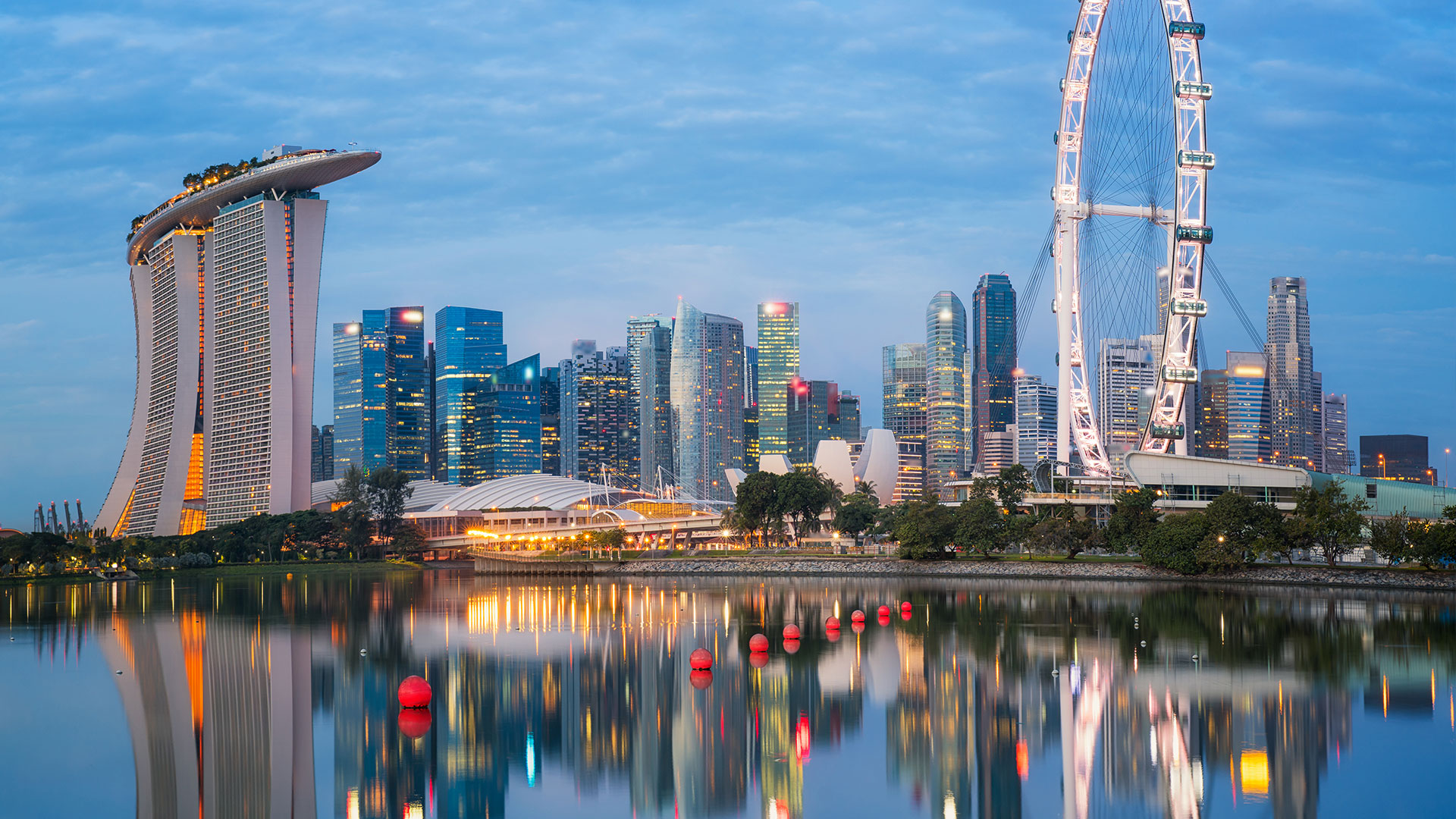Information correct as of September 2025
Authors: Andrew Digges and Nick Merritt
Market overview
As the world embraces the ideals of sustainability and works towards reduced reliance on fossil fuel sources of energy and reduction in greenhouse gas emissions, Singapore has set out how it plans to cut emissions to meet its 2030 Nationally Determined Contribution climate targets – with carbon capture technology expected to be among the most effective measures.1 The various efforts to cut emissions, called mitigation measures, were detailed in a biennial transparency report (which Singapore submitted to the United Nations in November 2024) reflecting a country’s greenhouse gas inventory and progress made in reaching climate targets. This report was the first to put a figure on the estimated quantity of emissions reductions that each mitigation measure could help achieve. It builds upon the Singapore Green Plan 2030 (which provides a sustainability road map)2 and Singapore’s Long Term Low Emissions Development Strategy, as well as contributing towards Singapore’s 2050 net-zero target.
Singapore’s greenhouse gas emissions measured about 58,590 kilotonnes of carbon dioxide (CO₂) or equivalent in 2022 and is expected to peak in 2028 before reducing to 60,000 kilotonnes in 2030. The mitigation measures detailed in the biennial transparency report mentioned above could help reduce Singapore’s emissions by up to12,000 kilotonnes by 2030, with the expectation that the use of carbon capture and storage (CCS) or carbon capture, utilisation and storage (CCUS) technology would contribute to 20 percent of the total emissions reductions, removing up to 2,500 kilotonnes of CO₂ equivalent by 2030.3
Various ministries and agencies, such as the Ministry of Trade and Industry, Ministry of National Development, the Energy Market Authority, the Economic Development Board and the National Climate Change Secretariat (an agency which contributed to the submitted 2024 United Nations report) are working closely together and with external partners in contributing to sustainability initiatives and projects related to CCUS.
Given that Singapore lacks suitable underground sites to facilitate CCS, Singapore seeks to work with other countries in the development of this technology. Some countries that Singapore is looking to collaborate with to lock up carbon or share best practices on the technology are Indonesia, Malaysia, Japan4, Brunei and Australia.
The following sections provide an overview of Singapore’s CCS / CCUS landscape, including projects, ongoing developments, strategic opportunities, and challenges shaping the sector’s trajectory.
Projects and initiatives
Some of the projects and initiatives that Singapore has undertaken and are ongoing are as per the below:
Awarding grants to support research, development and demonstration projects on low-carbon energy technology solutions – In 2021, under the Low-Carbon Energy Research Funding Initiative (LCER FI), the Singapore Government awarded $55 million to support 12 research, development and demonstration projects on low-carbon energy technology solutions, eight of which are CSS/CCUS projects, to support the decarbonisation of Singapore’s power and industry sectors.5
Working with S-Hub to evaluate the technical and economic feasibility of cross-border carbon capture projects – The Government has also been working with S-Hub (where the selected project company is a consortium comprised of Shell and ExxonMobil)6 to evaluate the technical and economic feasibility of cross-border carbon capture projects, with plans to develop a CCS project that can permanently store 2,500 kilotonnes of carbon a year by 2030, either in rock formations deep underground or under the seabed.7 The consortium will also seek to collaborate with regional partners to identify potential CO₂ storage sites.8
Launched a grant call to study two potential carbon capture and storage pathways for the power sector – The Energy Market Authority of Singapore is also exploring various low-carbon alternatives for the power sector and launched a grant call in 2024 to conduct feasibility studies on CCS for the power sector. The grant call sought to study two potential carbon capture and storage pathways, both of which involve capturing CO₂ emissions and storing them in underground storage sites9 and allows Singapore to use its existing natural gas infrastructure to achieve its decarbonisation goals.10 The two power sector CCS pathways are:
(a) a post-combustion carbon capture for combined-cycle gas turbines (CCGTs); and
(b) a pre-combustion carbon capture to produce hydrogen for power generation.11
Post-combustion carbon capture refers to the installation of an onsite CO₂ capture unit to capture CO₂ from waste gas produced during the combustion of natural gas in CCGTs. Pre-combustion carbon capture refers to the installation of an onsite CO₂ capture unit to capture carbon dioxide CO₂ generated during the production of hydrogen from natural gas. The hydrogen would then be combusted in CCGTs to generate power.12 In terms of eligibility for the grant, participants should be operating or bidding to operate an H-class CCGT on Jurong Island or Tuas by 2035 and must have completed a pre-feasibility study for either the post-combustion carbon capture or pre-combustion carbon capture pathway.13
Pilot project – Singapore will be launching a pilot by 2026 to test the viability of carbon capture technologies at its waste-to-energy plants.14
Developing a CCS project to aggregate CO₂ emissions on Jurong Island for overseas storage – The Singapore Government is also developing a carbon capture project to aggregate carbon dioxide emissions on Jurong Island for overseas storage, with Phase 1 likely to start around 2030. If proven feasible, the power sector CCS pathways mentioned above could potentially leverage future phases of the Jurong Island cross-border CCS project.15
Cross border collaborations:
- With Indonesia:
- Singapore has signed a letter of intent with Indonesia to collaborate on a cross-border CCS project that, when finalised, will allow companies in Singapore to ship their carbon to be stored there.16 This would be mutually beneficial for both Singapore and Indonesia in their climate ambitions. From Singapore’s perspective of Indonesia as a viable partner, the regulatory stance and capacity for carbon storage in Indonesia are encouraging. In January 2024, Indonesia issued a presidential regulation allowing CCS operators to allocate 30 percent of their storage capacity for imported CO₂. Indonesia is keen to become a hub for carbon CO₂ in the region and has stated that the archipelago has over 400 gigatonnes of storage capacity in the form of depleted oil and gas reservoirs and saline aquifers and 15 CCS and CCUS projects in various stages of preparation with a combined investment of nearly US$8 billion (S$10.8 billion).17
- With Australia:
- In 2020, Singapore signed a memorandum of understanding with Australia on cooperation on low-emissions solutions, including the exploration of new and emerging technologies which including CCUS.18
Development and support regime
While there are currently no specific regulations for carbon capture, there are dedicated teams in the Energy Market Authority’s Carbon Capture & Storage Programme Office (CCSPO) working towards advancing Singapore’s progress and development in the carbon capture and storage market. The works currently carried out by those teams include:
(a) analysing the feasibility of different types of technology;
(b) studying different business models and project structures to enable an end-to-end value chain; and
(c) working closely with industry stakeholders to better understand the CCS value chain and broker long-term partnerships.19
Opportunities and challenges
Opportunities
Useful and beneficial for hard-to-abate sectors – CCS projects would be useful and beneficial for hard-to-abate sectors such as chemicals, heavy manufacturing and even Singapore’s Waste-to-Energy plants, where emissions are generated as part of their production processes and where emissions would not be able to be completely mitigated through the use of renewable energy alone.20 CCS will thus allow Singapore to diversify its supply mix without compromising on its climate change commitments and meeting its net-zero target by 2050.21
Challenges
High cost of CCS technologies – The high cost of such technologies could impair economic feasibility. Cost varies according to the industrial sector and capture methods, storage location, the distance of transport and type22, and each CCS project needs to be customised to the specific needs of each site and involves complex design requirements.23 Additionally, CO₂ emissions tend to be released in diluted concentrations, making capture difficult, thus a lot of research would be required to explore ways to develop techniques to capture CO₂ in a cost-effective way.24 Greater technical expertise, which would add to costs, would also be needed to ensure that the chosen storage site has suitable geological features for CO₂ storage.25
Transportation considerations – Further, CO₂ captured will need to be compressed and/or liquefied before being transported for storage in deep underground formations such as saline aquifers and depleted oil and gas reservoirs. These must also be closely monitored to ensure the carbon does not escape back into the atmosphere, which means that there are also transportation and monitoring costs to consider. While other aspects of CCS have been tried and tested, the technology to transport liquefied CO₂ in large volumes is relatively nascent. Based on what is currently available in the market, ships that transport liquefied CO₂ are relatively small and Singapore’s project requires looking at larger ship sizes, which has not been done before.26
Singapore’s geographical limitations to store CO₂ locally – As already mentioned, Singapore also has limited potential to store CO₂ locally, given the lack of known suitable underground geological formations, and thus would require partnerships with its regional partners to ship CO₂ to them for potential storage.27
Hot topics / Areas of focus
One recent development is that a tender process is currently underway at the time of writing, being managed by the ‘Project Company’ (a joint venture of ExxonMobil and Shell) that is implementing the Singapore S-hub, to identify a ‘Transportation & Storage Service Provider’ that will have an initial role in loading liquefied CO₂ for shipping to and injection into a CCS storage facility.









